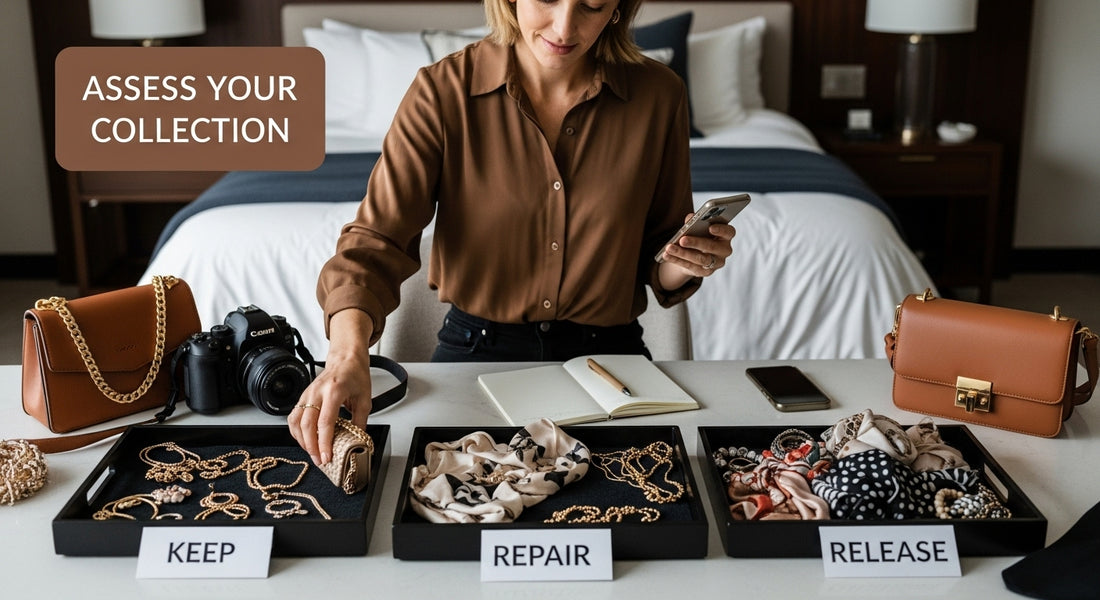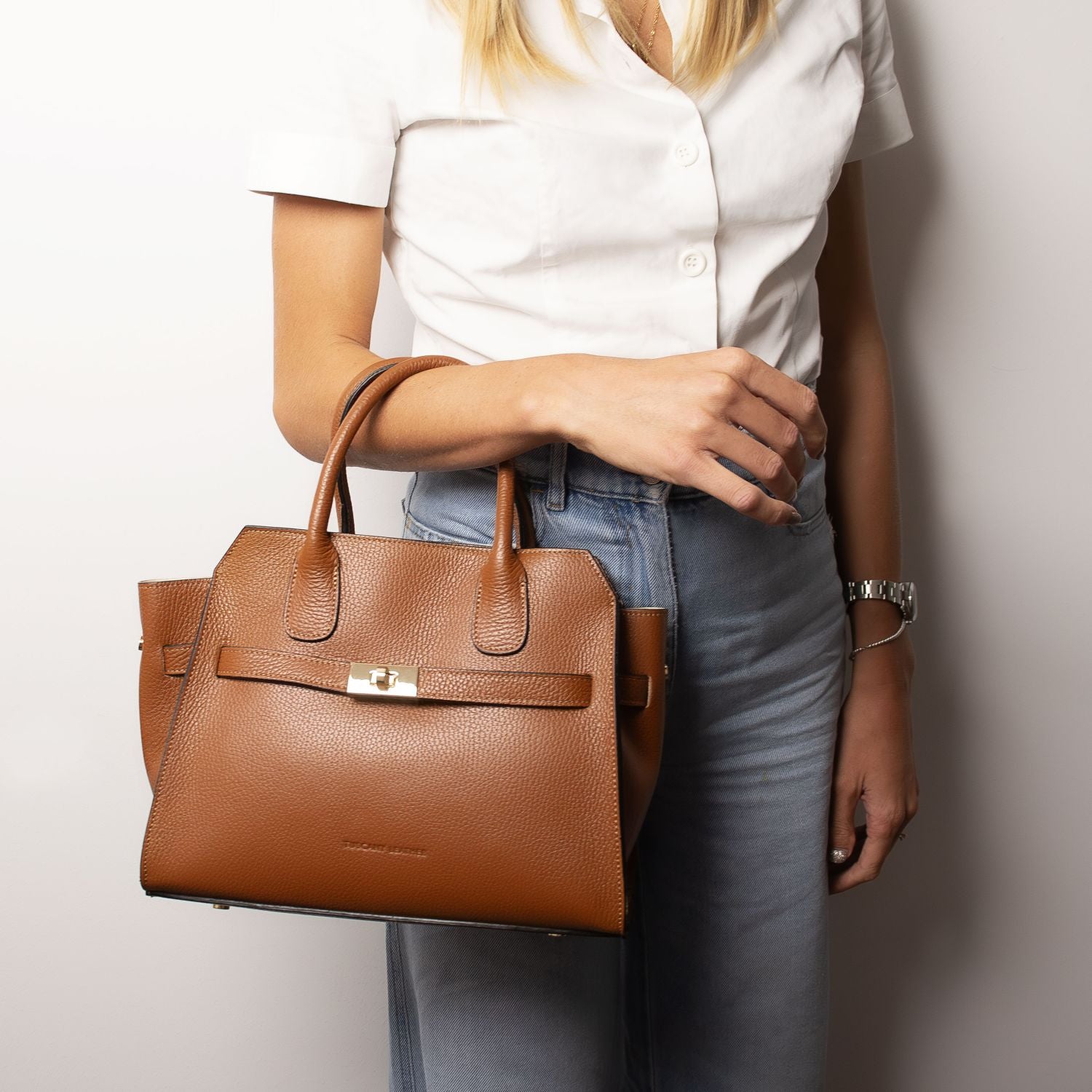
How to Organize Accessories for Effortless Elegance
Share

Most people feel overwhelmed when their accessories seem to multiply overnight and clutter up precious space. But the science of organisation tells a very different story. Systematically reviewing your belongings can actually reduce psychological clutter and boost your sense of wellbeing by a remarkable margin. So, what if taking just a few thoughtful steps could turn your jumbled drawers into a curated display that sparks genuine joy every morning?
Table of Contents
- Step 1: Assess Your Current Accessory Collection
- Step 2: Categorise Your Accessories By Type
- Step 3: Select Appropriate Storage Solutions
- Step 4: Arrange Accessories For Easy Access And Display
- Step 5: Regularly Review And Maintain Your Organised Space
Quick Summary
| Key Point | Explanation |
|---|---|
| 1. Assess your accessories thoroughly | Gather and categorise all items into Keep, Repair, and Release to gain clarity on your collection. |
| 2. Create logical categories | Organise accessories by type and usage frequency to streamline access and minimise decision fatigue. |
| 3. Invest in proper storage solutions | Choose storage that protects accessories while making them visible and accessible, ensuring they remain in good condition. |
| 4. Arrange for visual appeal and access | Display accessories in a visually pleasing way, keeping frequently used items easy to reach for convenience. |
| 5. Maintain your organised space regularly | Conduct quarterly reviews to check for wear and implement a maintenance routine for preserving your accessories. |
Step 1: Assess Your Current Accessory Collection
Organising your accessories begins with a thoughtful and strategic assessment of your current collection. This initial step is crucial for creating an elegant, functional system that transforms how you store and access your cherished items. The goal is to understand exactly what you own, its condition, and how each piece fits into your overall style narrative.
Start by gathering all your accessories in one spacious area with good lighting. Pull out every item from drawers, shelves, storage boxes, and hidden corners of your wardrobe. Spread them across a clean, flat surface like a large table or clean floor space. This comprehensive approach ensures nothing gets overlooked and allows you to see your entire collection at once.
As you review each piece, create three distinct categories: Keep, Repair, and Release. For the Keep category, select accessories that still align with your current style, are in excellent condition, and bring you genuine joy. These are pieces that make you feel confident and complement your aesthetic. The Repair category should include items with minor damage that can be professionally restored or mended, such as loose clasps, minor scuffs, or worn edges. The Release category encompasses accessories that no longer serve you – whether they’re outdated, damaged beyond repair, or simply no longer reflect your personal style.
According to research published in the International Journal of Environmental Research and Public Health, systematically reviewing personal items can significantly reduce psychological clutter and improve overall well-being. By methodically sorting your accessories, you’re not just organizing physical objects, but creating mental clarity and intentionality in your personal style.
During this assessment, take detailed notes. Document the condition of each piece, noting any maintenance requirements. Photograph items for your personal inventory, which can be helpful for insurance purposes and future organization. This documentation serves as a valuable reference point and helps you track the evolution of your accessory collection over time.

Verify your assessment is complete by ensuring you have:
Here is a checklist table to help you verify each important step after the assessment of your accessory collection, ensuring nothing is overlooked.
| Verification Step | Purpose |
|---|---|
| Reviewed every accessory | Guarantees a complete overview of all items owned |
| Created categorisation groups | Clarifies decisions by grouping into Keep, Repair, Release |
| Identified items needing repair | Ensures damaged pieces are flagged for professional attention |
| Determined pieces to donate or dispose | Removes unwanted clutter and prepares collection for organisation |
- Reviewed every single accessory
- Created clear, distinct categorization groups
- Identified items needing repair
- Determined pieces ready for donation or responsible disposal
Remember, this process is about curating a collection that truly represents your current style and brings you joy. Be honest with yourself about what you genuinely love and use, and don’t be sentimental about keeping items that no longer serve you.
Step 2: Categorise Your Accessories by Type
After assessing your collection, the next critical step in organizing accessories is creating a systematic categorisation method that brings clarity and ease to your storage approach. This strategy transforms a potentially overwhelming collection into a beautifully structured ensemble that reflects your personal style and functional needs.
Begin by establishing broad categories that naturally group your accessories. These typically include handbags, scarves, jewellery, belts, and small leather goods. Within each category, create subcategories that provide even more granular organisation. For handbags, this might mean distinguishing between evening clutches, daytime shoulder bags, and professional totes. For jewellery, consider separating pieces by occasion: everyday wear, formal events, and statement pieces.
Consider the frequency of use as a key organisational principle. Position frequently used accessories in easily accessible locations, while rotating less common items to secondary storage spaces. This approach ensures that your most beloved and regularly worn pieces remain conveniently within reach. Think about creating a dedicated area for grab and go accessories that you use most often, such as a small tray near your bedroom entrance or a specially designated drawer in your wardrobe.
A study on personal organisation published in the Journal of Consumer Research highlights how systematic categorisation can significantly reduce decision fatigue and enhance daily efficiency. By creating clear, logical groupings, you’re not just storing items, but creating a personalised system that streamlines your daily routine.
Material and colour can also serve as excellent secondary categorisation methods. Group leather accessories together, separate delicate silk scarves from more robust wool wraps, and consider arranging jewellery by metal type or colour palette. This approach not only looks aesthetically pleasing but helps prevent damage and makes maintenance easier.
Verify your categorisation is comprehensive by ensuring you have:
- Created clear, logical categories for all accessories
- Considered frequency of use in your storage placement
- Grouped items by material and potential maintenance requirements
- Identified any accessories that might require special storage conditions
Remember that categorisation is not a one-time task but an evolving process. As your style and collection change, be prepared to adjust your system. The goal is to create an organisational method that feels intuitive and brings you joy each time you access your accessories.
Step 3: Select Appropriate Storage Solutions
Selecting the right storage solutions transforms your accessory organisation from chaotic to curated, creating a system that protects your treasured pieces while making them beautifully accessible. The perfect storage approach balances protection, visibility, and aesthetic harmony, ensuring each accessory remains in pristine condition while complementing your personal style.
Consider investing in specialised storage fixtures that cater to specific accessory types. Handbags, for instance, require structured support to maintain their shape. Opt for adjustable shelf dividers or dedicated bag stands that prevent slouching and minimize creasing. For delicate leather items, use soft, breathable dust bags or cotton pillowcases that protect against dust while allowing air circulation. Scarves and lightweight accessories benefit from padded hangers or rolled storage methods that prevent unnecessary stretching or permanent creasing.
Jewellery demands particularly thoughtful storage solutions. Select compartmentalised trays with soft, fabric-lined sections to prevent scratching and tangling. Consider using clear, stackable acrylic organisers with multiple sections, which allow you to see your entire collection at a glance while keeping individual pieces separate. Hanging jewellery organisers with clear pockets can be an excellent solution for those with limited drawer or shelf space, providing both visibility and protection.
According to storage experts at the Northern States Conservation Center, selecting storage with appropriate material characteristics is crucial. Steel shelving with powder coating offers superior durability and protection compared to traditional wooden storage, which can potentially off-gas chemicals that might damage delicate accessories.
Vertical space utilisation is another key strategy in efficient accessory storage. Install adjustable shelving that can accommodate accessories of varying sizes, ensuring you can modify your storage as your collection evolves. Use the top shelves for less frequently used items and keep everyday accessories at eye level or in easily accessible drawers. Consider introducing modular storage systems that can be reconfigured as your collection changes, providing flexibility and long-term utility.
Verify your storage solution is effective by checking that:
- Each accessory type has a designated, appropriate storage space
- Items are protected from dust, direct sunlight, and potential damage
Below is a summary table of suitable storage solutions for different types of accessories based on the guidance provided, including core safeguarding considerations.
| Accessory Type | Recommended Storage Solution | Protection Focus |
|---|---|---|
| Handbags | Shelf dividers, bag stands, dust bags | Maintain shape, prevent dust |
| Scarves | Padded hangers, rolled storage | Prevent creasing, protect fabric |
| Jewellery | Compartmentalised trays, acrylic organisers, hanging organisers | Prevent tangling/scratching |
| Leather goods | Breathable dust bags, cotton covers | Air circulation, avoid cracking |
| Belts | Dedicated rack, rolled in drawer | Retain structure, ease of access |
- Storage solutions are easily accessible and intuitive to use
- The overall system maintains the condition and shape of your accessories
Remember that storage is not just about functionality, but also about preserving the beauty and quality of your accessories. Choose solutions that not only protect your items but also bring you joy every time you interact with them.

Step 4: Arrange Accessories for Easy Access and Display
Arranging your accessories is the transformative step that turns organised storage into a personal style sanctuary. This process goes beyond mere functionality, creating a visual narrative that celebrates your collection while ensuring each piece remains easily accessible and beautifully preserved.
Consider implementing a colour-gradient approach when displaying your accessories. Arrange items from lightest to darkest shades, creating a visually harmonious transition that makes selecting pieces intuitive. For handbags, this might mean progressing from cream and pale neutrals through soft pastels to deep earth tones and eventually rich blacks. This method not only looks aesthetically pleasing but also helps you quickly identify and select the perfect accessory for any outfit.
Frequency of use should dictate your primary placement strategy. Position your most-used accessories in prime, easy-to-reach locations. A sleek tray near your wardrobe entrance can house everyday jewellery, while a dedicated hook or stand can display your go-to handbag. Less frequently used statement pieces can be stored slightly higher or in protected display cases that allow appreciation without constant handling.
According to storage experts at the Virtual Lab School, creating an organisational system that promotes easy access is crucial. This means thinking strategically about visibility and reach. Use transparent containers or open shelving for items you want to see and access quickly. Install adjustable shelving that can accommodate accessories of varying sizes, ensuring your storage evolves with your collection.
Think about creating visual clusters that tell a story. Group metallic jewellery together, creating a gleaming display that highlights the individual beauty of each piece. Arrange scarves in elegant cascades that showcase their patterns and textures. For leather goods, consider displaying them in a way that maintains their shape – stuff handbags lightly to prevent sagging, and use dust bags or protective covers when not in use.
Verify your arrangement is effective by ensuring:
- Everyday accessories are within immediate reach
- Delicate items are protected from potential damage
- The overall display reflects your personal aesthetic
- Each accessory is visible and easily identifiable
Remember that your accessory arrangement is a living system. Be prepared to adjust and refine your approach as your collection grows and your style evolves. The goal is to create a storage solution that not only protects your treasured pieces but also brings you joy every time you interact with it.
Step 5: Regularly Review and Maintain Your Organised Space
Maintaining your meticulously organised accessory collection is an ongoing process that requires consistent attention and thoughtful care. This final step transforms your initial organisation efforts into a sustainable system that evolves with your personal style and protects your cherished pieces.
Establish a quarterly review ritual dedicated to assessing your accessory collection. Set aside a specific time every three months to thoroughly examine your storage system, checking for signs of wear, potential damage, or changes in your style preferences. During these reviews, inspect leather goods for any developing scuffs or signs of aging, check metal accessories for potential tarnishing, and evaluate whether your current organisation method continues to serve your needs effectively.
Implement a proactive maintenance approach that goes beyond simple visual inspection. For leather accessories, use specialised leather conditioners every six months to prevent cracking and maintain suppleness. Clean and polish metal jewellery using appropriate cleaning solutions, ensuring delicate pieces retain their original lustre. Silk scarves and delicate fabrics might require professional cleaning or careful hand washing to maintain their quality and prevent potential damage.
According to the Northeast Document Conservation Center, regular housekeeping is a fundamental preventive conservation strategy. Dust and environmental factors can gradually degrade accessories, so develop a consistent cleaning routine. Use soft, lint-free cloths for wiping storage areas, and consider using acid-free tissue paper to stuff handbags and maintain their shape during periods of non-use.
Technology can be an excellent ally in maintaining your organised space. Create a digital inventory using smartphone apps or spreadsheet software, documenting each accessory’s condition, purchase date, and maintenance history. This digital record not only helps track your collection but can also be valuable for insurance purposes and personal reference.
Verify your maintenance approach is comprehensive by ensuring you have:
- Conducted a thorough quarterly review of your entire collection
- Cleaned and conditioned accessories appropriate to their material
- Updated your digital or physical inventory
- Identified any accessories requiring professional repair or replacement
Remember that maintaining your organised accessory space is not about perfection, but about creating a system that brings you joy and makes your daily routine more streamlined. Your collection is a reflection of your personal style, and its care should be an enjoyable, mindful process that celebrates your unique aesthetic.
Transform Your Accessory Organisation with San Rocco Italia
Have you found that even after sorting and categorising your accessories, your current collection still lacks that sense of cohesion and effortless elegance? Many readers of our guide feel the frustration of owning beautiful items without a truly functional way to showcase or protect them. If your goal is to curate a wardrobe filled with pieces that reflect your style and remain in pristine condition, high-quality storage and investment in timeless accessories are essential. The article highlights the importance of thoughtful selection, effective categorisation, and the joy of maintaining items crafted with care.

Discover how you can elevate your organisation journey at San Rocco Italia where unparalleled craftsmanship meets lasting style. Our boutique collection features luxury leather handbags and accessories, made in Italy by skilled artisans using only full-grain leather. Add pieces to your collection that deserve careful display. Shop our luxury handbags and leather goods, designed to stay elegant season after season, and explore our curated European selections for extra refinement. Treat yourself and your wardrobe to an upgrade that celebrates quality and makes every step of your organising journey truly rewarding. Visit us today to experience the art of timeless organisation.
Frequently Asked Questions
How should I assess my current accessory collection?
To assess your accessory collection, gather all items in one area, categorise them into ‘Keep’, ‘Repair’, and ‘Release’, and document their condition and maintenance requirements. This helps you gain clarity on what you own and the state of each piece.
What categories should I use to organise my accessories?
You can categorise your accessories into broader groups such as handbags, scarves, jewellery, belts, and small leather goods. Within these categories, you can create subcategories based on style, occasion, and frequency of use for better organisation.
What are the best storage solutions for different types of accessories?
Select storage solutions based on the type of accessory. For example, use structured supports for handbags, compartmentalised trays for jewellery, and padded hangers for scarves. Choose materials that offer protection, like soft dust bags for leather items.
How often should I review and maintain my organised accessory space?
It’s advisable to review your accessory collection every three months to check for signs of wear or changes in your style. Regular maintenance includes cleaning, conditioning, and updating your inventory to ensure everything remains in good condition.


